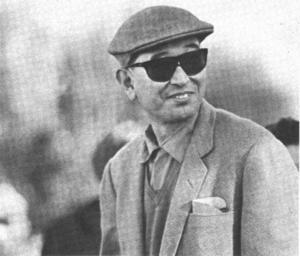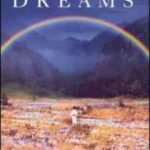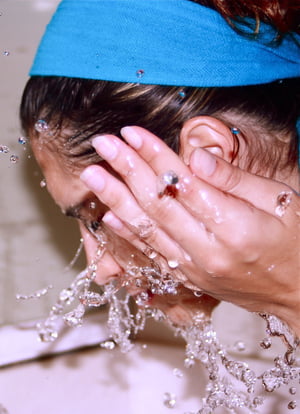Akira Kurosawa was born on March 23, 1910 to the descendents of a samurai family, with seven brothers and sisters. His childhood was marred repeatedly by death and destruction, all three of his brothers dying premature deaths, as well as one of his sisters. He lived through the 1923 Tokyo earthquake, in which 100,000 people died, surveying the scene with his older brother. These traumatic experiences taught him to approach the harder things in life head on, to tackle fear rather than run from it, a theme that repeatedly showed up in his films.
He began his film career at age 26 working in a Film Directors Apprenticeship program for Nikkatsu. By the time he made his directorial debut in 1943, Japan was at war and his next few films, under the watchful eyes of a war time military government reflected this as wartime propaganda (something the American film industry was not averse to itself).
Finally in No Regrets for Our Youth, he was given more freedom and crafted his first film critical of the old Japanese regime. He followed with many takes on contemporary life in Japan including the noir pieces Drunken Angel and Stray Dog, first working with the legendary Toshiro Mifune – his samurai of choice later on – in Drunken Angel.
But it was a period piece, a 16th century Samurai film that brought Kurosawa the world wide recognition that would later place him as one of the greatest directors of the century. The Venice Film Festival, Golden Bear Winning Rashomon was released in 1950. It was in this genre, the period Samurai picture, that Kurosawa would find his greatest successes. In all, he made nine such films, ranging from original pictures written by him to epic translations of Shakespeare (something he did twice)
Rashomon – The film that introduced the world to Kurosawa. Three people meet in the woods and a crime transpires. The film takes place where each of them tells their story to the local governor at trial, each story is different and the viewer is left to figure out what happened. Toshiro Mifune makes his first period piece performance for Kurosawa. The film went on to win the Golden Bear at the Venice Film Festival and catapulted Kurosawa’s name to the top of many best of world cinema lists. The story telling method used in this film is a common narrative technique now, in which multiple characters retell the same events in different manners.
Seven Samurai – This is the most important film he made, and one of the most important films ever made. He invented camera shots, invented filming techniques, crafted a story that’s been copied dozens of times, and it’s all his, written and directed. Seven Samurai are hired by a local village under attack by bandits to help defend them. The Samurai must lend their skills and their courage to help the villagers stand up to such an onslaught and learn to fight for themselves. Hollywood has since copied this film multiple times, most notably in Yul Brenner’s Magnificent Seven.
Hidden Fortress – The basis for Star Wars was a Kurosawa film. Watch this classic and you’ll see why. A rogue general must accompany a princess to her home while trying to bypass bandits who seek to kill her. Two goofy Ronin tag along for the ride. It’s got the trademark goofy humor of Kurosawa that would later show up in Yojimbo and Sanjuro prominently as well as the strong storytelling power if its director; so good George Lucas couldn’t pass it up.
Yojimbo/Sanjuro – Two films really, but they’re the same character in a similar story. A roaming samurai (a Yojimbo) stumbles into a town torn apart by two rival gangs. He decides that none of them are worth living and so plays a game of working for one and then the other to see that they all see their demise, all the while making a pretty penny. Sergio Leone later took Yojimbo and adapted it into the first of his Man With No Name trilogy with Clint Eastwood, A Fist Full of Dollars.
Throne of Blood – Kurosawa was an avid fan of western literature and Shakespeare in particular. He had planned an adaptation of Macbeth for many years but when the funding finally came through he went to town. Throne of Blood is as epic as the play from which it’s adapted and entirely Japanese all at the same time. All of Shakespeare’s metaphors are intact and yet the entire method of them is reworked. Only Kurosawa could pull this off so seamlessly.
Kagemusha – Japanese for Shadow, The Kagemusha is a man chosen to stand in for a warlord in battle. Released in 1980, the film was cofunded by Francis Ford Coppola and George Lucas, enormous fans of Kurosawa’s work who wanted to see him make this film, even though the funding wasn’t there in Japan. The result was a striking commentary on Feudal Japan, the film taking place in the 16th century Warring States Period.
Ran – This was the last of Kurosawa’s epics, at the tail end of his career when it was hard for him to not only find funding but put the films together. In terms of funding, it was the most expensive Japanese film ever at that point, with a budget of $12 million. The film is a re-envisioning of King Lear, Shakespeare’s classic tragedy through a distinct Japanese legend of Daimyo Mori Motonari. The result is a huge, epic tale of sons fighting and murdering for the rights to their father’s estates. The colors and costumes were incredible, earning an Academy Award for costume design. It’s long and depressing yes, but it’s one of his best films.
Of the 28 films Akira Kurosawa made, a third of them were epic Jidaigeki (period films), taking from Japanese history and Western culture and crafting some of the greatest Samurai films, in some cases any films, of all time.




